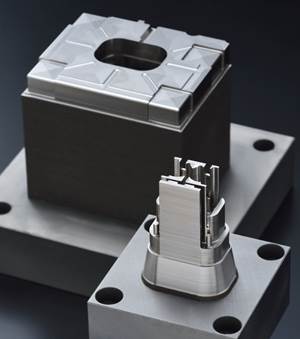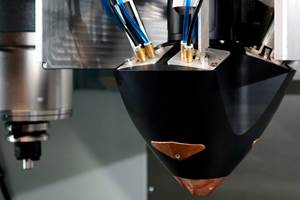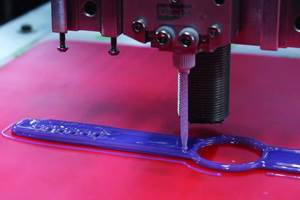Video: Update on Hybrid Manufacturing
Greg Hyatt of DMG MORI notes expanded range of subtractive operations and applications likely to benefit from hybrid.
Share
Read Next
DMG MORI continues to explore and advance the “hybrid” concept combining additive and subtractive operations into one machine, says Greg Hyatt, vice president and chief technical officer for the company. He describes the company’s progress in this video. Grinding and ultrasonic machining are additional subtractive operations that can complement additive, he says, and in the future, industries not typically associated with additive manufacturing are likely to show interest in this means of making parts.
Transcript:
Pete: I’m Pete Zelinski with Additive Manufacturing magazine. I’m here with Greg Hyatt, senior vice president and chief technical officer with DMG Mori. Dr. Hyatt, you have been involved for a number of years now in hybrid manufacturing. Hybrid systems combining additive manufacturing with CNC machining in a single platform. Make the case for the hybrid concept, why is that idea valuable for deploying additive manufacturing?
Greg: I think it’s absolutely essential, as we move from applying additive largely to rapid prototyping to actual production of parts because what’s most exciting about additive is the new designs that are enabled, that it enables design engineers to take what were previously assemblies, build those as a single piece, eliminating the joints and flanges, the leakage, the assembly time, but that means the machined features get trapped inside. So, it’s impossible to machine those features after the fact. The only way to give the design engineers that degree of freedom is to be able to machine them in process.
Pete: Yeah, DMG Mori was among the first leaving machine tool builders to introduce a hybrid machine. It’s been out there for a little while now. What have you learned, are there ways you’ve gotten a better sense of the possibilities for this machine and what can it do?
Greg: Yes, we’ve expanded. I guess our definition from hybrid from including only milling and turning to grinding and ultrasonic machining, which extends the range of applications extends the range of work that can be consolidated into a single operation, and that has been exciting.
Pete: I wonder if you could talk about a recent test or experiment with the hybrid machine? Is there any new application that you’re playing with or learning about right now?
Greg: No, there are dozens, so, but I think you’re gonna force me to talk about one, so I think I would choose titanium and the reactive metal. The traditional solutions that have addressed the unique challenges of reactive metals and additive machinery don’t apply to the hybrid so we had to invent our own enabling technology. We’ve done and we’ve commercialized titanium and in the future, we’ll be extending the reactive portfolio into other alloys.
Pete: Additive and machining our complementary processes recognizing that, what is the future that you see? Are there particular sectors, industries, types of products that are particularly prone to be affected going forward by additive and machining working in tandem?
Greg: Yes, I think in particular we’ll see a lot of interest in the coming year or two. In heavier components from energy in general, oil and gas, mining, also agriculture, industrial equipment, the fields where the components are large and they didn’t fit in the original generation of additive equipment. So, there’s a large pent-up demand to be able to build these longer, more robust components that is finally being enabled.
Related Content
Hybrid Metal 3D Printer Enables Quick-turn Prototyping
IMTS: Matsuura Machinery’s Lumex Avance hybrid metal 3D printers are said to enable lights-out production for highly accurate parts from metal powders.
Read MoreCNC Engineering Integrates 3D Printing Solutions With CNC Machine Tools
CNC Engineering and Meltio have collaborated to design a solution that combines the power and reliability of FANUC CNC with cutting edge additive manufacturing technology.
Read MoreJuggerBot 3D Awarded $4 Million by Air Force to Develop Large Format Hybrid Additive System
The project focuses on advancing the ability to print a thermoset composite material that can transform the way an aircraft structure is designed, fabricated and sustained for limited-life aircraft.
Read MoreLarge-Format “Cold” 3D Printing With Polypropylene and Polyethylene
Israeli startup Largix has developed a production solution that can 3D print PP and PE without melting them. Its first test? Custom tanks for chemical storage.
Read MoreRead Next
Hybrid Additive Manufacturing Machine Tools Continue to Make Gains (Includes Video)
The hybrid machine tool is an idea that continues to advance. Two important developments of recent years expand the possibilities for this platform.
Read MoreAt General Atomics, Do Unmanned Aerial Systems Reveal the Future of Aircraft Manufacturing?
The maker of the Predator and SkyGuardian remote aircraft can implement additive manufacturing more rapidly and widely than the makers of other types of planes. The role of 3D printing in current and future UAS components hints at how far AM can go to save cost and time in aircraft production and design.
Read More4 Ways the Education and Training Challenge Is Different for Additive Manufacturing
The advance of additive manufacturing means we need more professionals educated in AM technology.
Read More





















